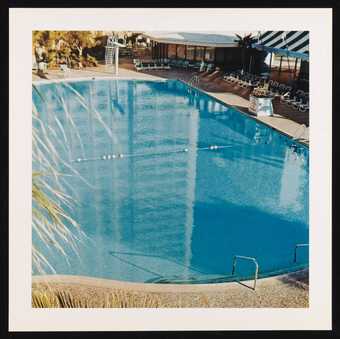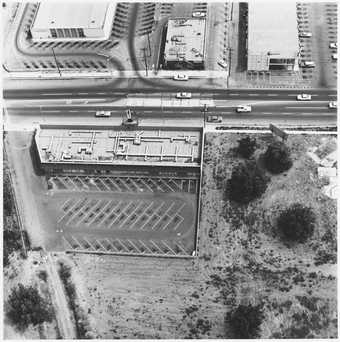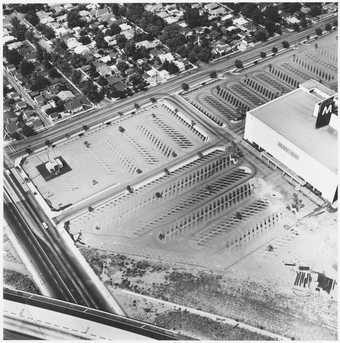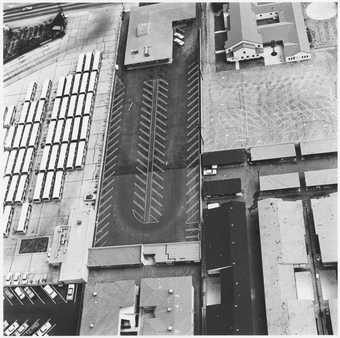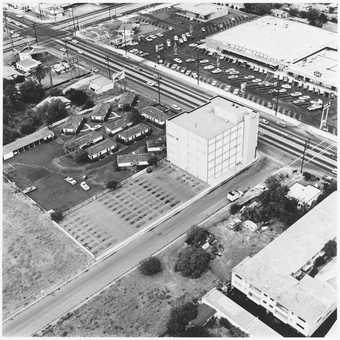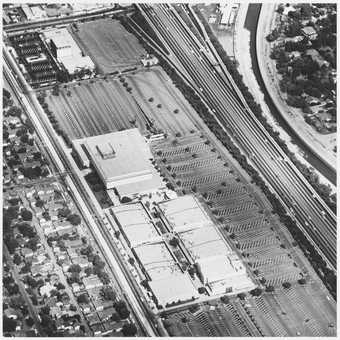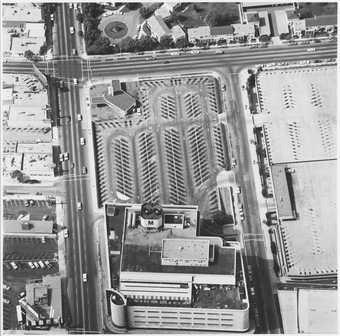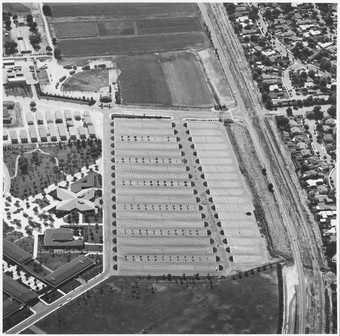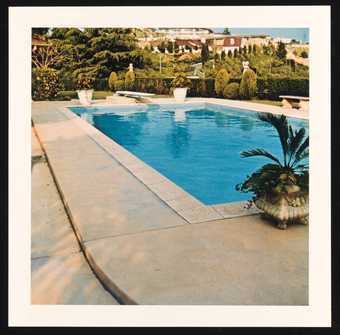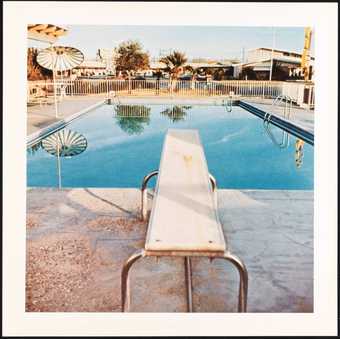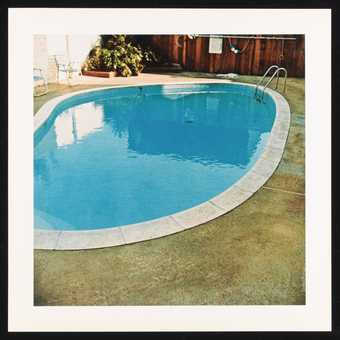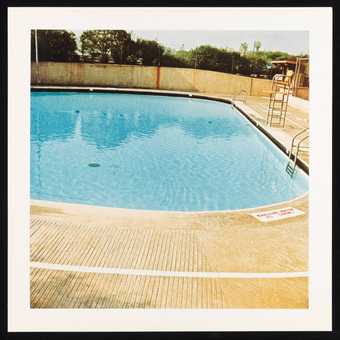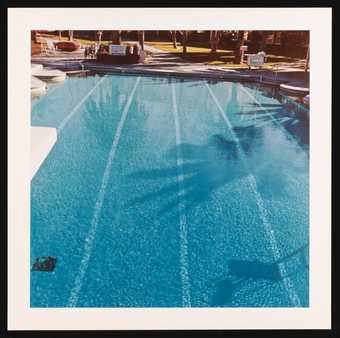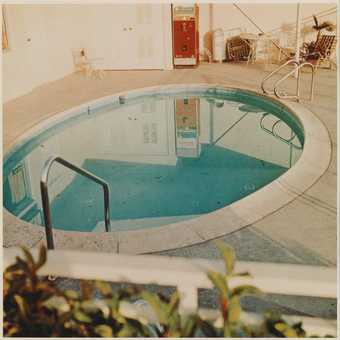
Not on display
- Artist
- Edward Ruscha born 1937
- Medium
- Photograph, colour on paper
- Dimensions
- Unconfirmed, image: 394 × 394 mm
unconfirmed, support: 610 × 610 mm
frame: 580 × 580 × 45mm - Collection
- ARTIST ROOMS
Tate and National Galleries of Scotland. Lent by Artist Rooms Foundation 2011
On long term loan - Reference
- AL00281
Summary
This colour photograph depicts a portion of a swimming pool on a bright sunny day. The pool takes up most of the frame and has an irregular shape: three of its sides are visible towards the top of the image, along with three submerged steps that occupy the corner between two of these sides, and two white pillars that stand near the edge of pool and cast shadows to the right. The water towards the left-hand side of the pool is a deep azure blue, while on the right-hand side it is lighter in colour. A section of a white diving board can be seen in the bottom-right corner of the image, although the edge of the pool to which it is attached has been cropped out of the scene. No figures appear in the image, although human presence is suggested by ripples in the water, which appear to originate from the right beneath the diving board. In contrast to the water in the foreground, the far side of the pool is relatively still.
Pool #9 was taken in 1968 and formed part of Ed Ruscha’s book Nine Swimming Pools and a Broken Glass, which, as the title indicates, includes nine photographs of swimming pools (see Tate AL00274, AL00275, AL00276, AL00277, AL00278, AL00279, AL00280, AL00226) and one of a broken glass tumbler. All the pools are located at low-budget Las Vegas motels. In 1997 the nine photographs of swimming pools were each reprinted in editions of thirty. Pool #9 is one such colour print.
Nine Swimming Pools and a Broken Glass continues Ruscha’s project of documenting the Los Angeles landscape. Yet it departs from his previous photographic publications (such as Twentysix Gasoline Stations 1963 and Some Los Angeles Apartments 1965) in that the images are printed in colour and that, individually and collectively, the ten photographs, with the broken glass at the end, hint at some kind of narrative. In this respect the photographs not only record aspects of the urban landscape but also engender emotional reactions. As the art historian Mary Richards has stated, the image of the broken glass ‘leaves a feeling of rupture after the pools – glass being the last thing you would want to find under your feet when going for a swim’ (Richards 2008, p.39).
Even when considered in isolation, Pool #9 bears a sense of unease: the ripples in the water suggest that someone has just jumped into the pool from the diving board, yet, strangely, nobody can be seen. Indeed, the way in which the image has been cropped, so as to eliminate contextual details, heightens a sense of the uncanny. However, the photographs chosen for Nine Swimming Pools and a Broken Glass are not entirely ominous; there is a lightness and a brightness to them as well. As the art historian Alexandra Schwartz has stated, ‘these low-rent resorts speak to the notion that fantasies of sun and surf are available to everyone, from motel patrons paddling around in those run-down but beautifully blue swimming pools, to multimillionaire movie stars who have the real thing in their backyards’ (Schwartz 2010, p.162). Ultimately, however, Schwartz came to the conclusion that the photographs convey ‘an ambivalence about the Southern Californian lifestyle’ (Schwartz 2010, p.162). There is cool detachment at play; the photographs neither glorify nor denounce California’s easy living.
Further reading
Sylvia Wolf, Ed Ruscha and Photography, New York 2004.
Mary Richards, Ed Ruscha, London 2008.
Alexandra Schwartz, Ed Ruscha’s Los Angeles, Cambridge, Massachusetts 2010.
Thomas Flanagan
The University of Edinburgh
November 2014
The University of Edinburgh is a research partner of ARTIST ROOMS.
Does this text contain inaccurate information or language that you feel we should improve or change? We would like to hear from you.
Display caption
This image was included in Ruscha’s artist’s book Nine Swimming Pools and a Broken Glass 1968. This was Ruscha’s first colour photographic series. As the title indicates, the book includes nine photographs of pools and one of a broken glass tumbler, placed at the end almost like the punchline of an absurd visual joke. This series continues Ruscha’s project of documenting the Los Angeles landscape. All the pools are located at low-budget motels. These highly artificial leisure spaces can be seen as symbolic of Southern California’s ‘easy living’ culture.
Gallery label, July 2019
Does this text contain inaccurate information or language that you feel we should improve or change? We would like to hear from you.
Explore
- architecture(30,960)
-
- public and municipal(2,385)
-
- baths(53)
- formal qualities(12,454)
-
- photographic(4,673)
- sequence(156)
- sports and games(230)
-
- diving board(5)
- countries and continents(17,390)
-
- USA, California(112)
You might like
-
Edward Ruscha Pool #8
1968, printed 1997 -
Edward Ruscha Eileen Feather Salon, 14425 Sherman Way, Van Nuys
1967, printed 1999 -
Edward Ruscha May Company, 6150 Laurel Canyon, North Hollywood
1967, printed 1999 -
Edward Ruscha State Board of Equalization, 14601 Sherman Way, Van Nuys
1967, printed 1999 -
Edward Ruscha 7101 Sepulveda Blvd., Van Nuys
1967, printed 1999 -
Edward Ruscha Fashion Square, Sherman Oaks
1967, printed 1999 -
Edward Ruscha May Company, 6067 Wilshire Blvd.
1967, printed 1999 -
Edward Ruscha Pierce College, Woodland Hills
1967, printed 1999 -
Edward Ruscha Pool #1
1968, printed 1997 -
Edward Ruscha Pool #2
1968, printed 1997 -
Edward Ruscha Pool #3
1968, printed 1997 -
Edward Ruscha Pool #4
1968, printed 1997 -
Edward Ruscha Pool #5
1968, printed 1997 -
Edward Ruscha Pool #6
1968, printed 1997 -
Edward Ruscha Pool #7
1968, printed 1997

